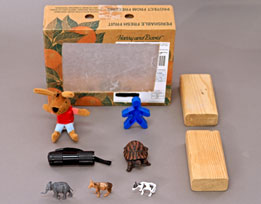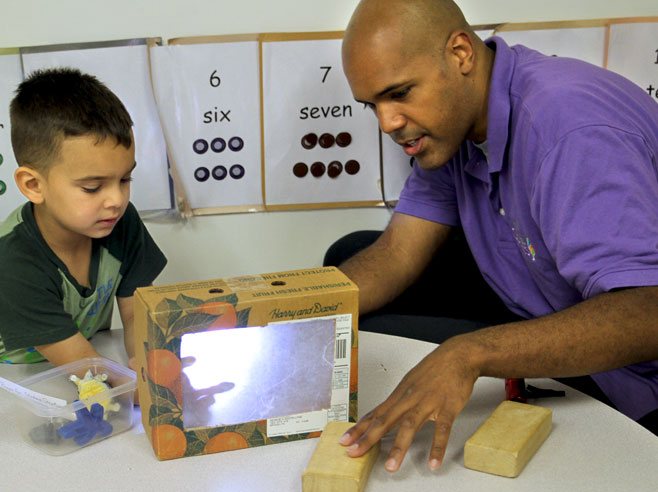Children explore how to make the shadow of an object inside the shadow theater bigger, smaller, and clear enough to identify by moving a flashlight closer and farther away.
Materials

- Collection of small plastic farm animals, toy cars, and other similar-sized objects
- Flashlight for each shoebox theater
- Shoebox(es) (1 large or medium-sized box for each shoebox theater)
- Tape
- Wax paper for each shoebox theater (for a shadow surface)
- Wooden block for each shoebox theater (for a “stage”)
Preparation
- Make 1–2 shoebox shadow theaters as follows:
- Cut a rectangle out of the bottom of the shoebox, leaving a rim on all four sides. The opening will be slightly smaller than the box bottom.
- Tape a piece of wax paper or white paper to the inside of the box, covering the opening. This will be the shadow screen.
- Place a block inside the box to serve as a stage for the mystery object. This should ensure that the entire shadow of the object can be seen from the other side of the screen.
- The box(es) will be used in the Learning Center. If you want more children to be able to explore, think about creating one or two more box theaters for the Learning Center.
Directions: Lesson 6
Circle Time: Introduction
- Introduce children to the shoebox shadow theater. Place a mystery toy (animal or vehicle) on the block inside the box. Hold a lit flashlight close to the toy. Explain that you are holding the flashlight very close to the mystery toy in this shoebox shadow theater and there’s a very big fuzzy shadow of the toy filling the screen on the front of this box. Can you tell what it is? (Probably not!)
- Explain, I think if I make the shadow smaller, it will be clearer and easier to tell what the object is. Move the light closer to the object. Is the shadow bigger or smaller now? How should I move my flashlight to make the shadow smaller and clearer? Follow children’s instructions and move the flashlight farther away from the toy so that a smaller, sharper shadow can be seen on the screen. Explain that the mystery toy is blocking less light when the flashlight moves farther from it. Can children guess the mystery toy?
- Have a few volunteers create a shadow. Encourage the audience to describe the shadow. Have the shadow maker change the shadow size if it is too small.
Learning Center
- Invite children to explore big and small shadows with one or two partners. Observe how children work together on the shadow plays. Children should take turns placing mystery toys on the stage inside the box and shining their flashlight on the toys.
- Use prompts such as those below or those used during earlier group explorations to engage children in discussion about shadows:
- Can the audience see the shadow?
- Is the shadow big or small? How can you make it bigger/smaller?
- Encourage children to listen to and build on each other’s ideas.
Directions: Lessons 8, 10, 11, 12
Learning Center
- Invite children to explore big and small shadows with one or two partners. Observe how children work together on the shadow plays. Children should take turns placing mystery toys on the stage inside the box and shining their flashlight on the toys.
- Use prompts such as those below or those used during earlier group explorations to engage children in discussion about shadows:
- Can the audience see the shadow?
- Is the shadow big or small? How can you make it bigger/smaller?
- Encourage children to listen to and build on each other’s ideas.


